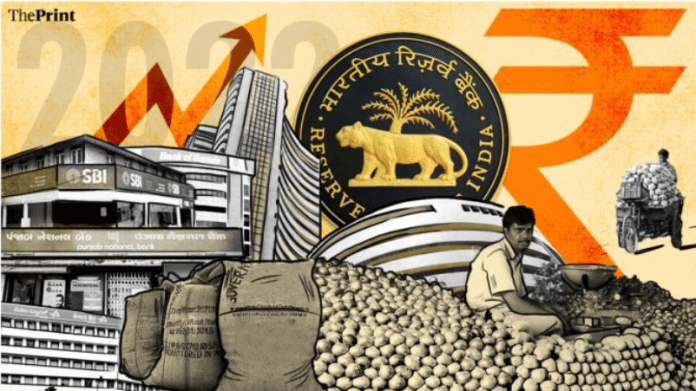Thank you dear subscribers, we are overwhelmed with your response.
Your Turn is a unique section from ThePrint featuring points of view from its subscribers. If you are a subscriber, have a point of view, please send it to us. If not, do subscribe here: https://theprint.in/subscribe/
In a world wrestling with uncertainty, India stands tall as a rare economic bright spot. The International Monetary Fund’s latest projection of a 6.6% growth rate for India, even as global expansion slows to a crawl, reinforces what many economists have been observing, that India’s growth story is not merely a flash in the pan but a structural shift taking root. Amid rising geopolitical tensions, supply chain realignments, and persistent inflationary pressures worldwide, India’s resilience is not just noteworthy; it is defining a new chapter in the global economic order.
The IMF’s outlook comes at a time when major economies are struggling to maintain momentum. The United States is grappling with high borrowing costs; the Eurozone remains burdened by sluggish industrial output; and China’s growth, once the engine of global expansion, has lost its earlier pace due to structural challenges and a faltering real estate sector. In contrast, India’s trajectory is powered by strong domestic demand, government-led infrastructure spending, and a digital transformation that continues to redefine productivity and inclusivity.
At the heart of India’s growth story lies its consumption-driven economy. With a burgeoning middle class and rising disposable incomes, domestic demand has served as a natural cushion against external shocks. The recovery in urban consumption, seen in robust automobile sales, real estate activity, and hospitality sector growth, is complemented by a steady revival in rural spending as agricultural output stabilizes. The government’s continued emphasis on welfare schemes, direct benefit transfers, and rural infrastructure has also supported demand in semi-urban and rural India.
Equally critical is the government’s push for capital expenditure. The Union Budget for 2024–25 once again prioritized infrastructure, with record allocations to roads, railways, ports, and energy transition projects. This emphasis on capital formation not only generates employment but also crowds in private investment by improving connectivity and logistics. The ripple effects of such spending are already visible in the uptick in core sector growth and a surge in private capital expenditure across manufacturing, renewable energy, and defence sectors.
India’s digital ecosystem, often hailed as one of the most advanced among emerging economies, continues to be a silent yet powerful driver of growth. The success of the Unified Payments Interface (UPI), the spread of affordable data, and the expansion of digital public infrastructure have not only boosted financial inclusion but also created new opportunities for entrepreneurs, especially in Tier 2 and Tier 3 cities. The startup ecosystem, though facing a global funding winter, remains vibrant, with innovation thriving in sectors like fintech, health-tech, and agri-tech.
However, India’s growth narrative is not without challenges. The uneven recovery in rural areas, persistent youth unemployment, and the need for higher female labour force participation remain pressing concerns. Moreover, global headwinds, from rising oil prices to geopolitical tensions in West Asia and Eastern Europe, could pose near-term risks to inflation and fiscal balances. To sustain momentum, India must continue focusing on structural reforms, particularly in land, labour, and logistics, while nurturing human capital through education and skilling initiatives.
What distinguishes India today is the growing confidence that its growth is increasingly self-sustaining. Unlike in previous decades, when external capital and exports dictated economic fortunes, today’s growth rests largely on domestic foundations. The country’s foreign exchange reserves remain strong, inflation is moderating within manageable limits, and macroeconomic stability has given policymakers room to manoeuvre.
Globally, investors are taking note. Multinationals seeking alternatives to China are finding India an attractive destination for manufacturing, supported by the government’s Production Linked Incentive (PLI) schemes and improving ease of doing business. From semiconductors to electric vehicles, India’s industrial ambitions are aligned with global technological shifts, promising to elevate the nation’s role in future supply chains.
In essence, the IMF’s 6.6% growth projection is not merely a statistic, it is a validation of India’s growing economic maturity and its capacity to chart its own path amid global turbulence. As the world’s fifth-largest economy continues its ascent, the challenge for policymakers will be to ensure that this growth remains inclusive, sustainable, and innovation-driven. If India can balance reform with resilience, its story may well become the defining economic narrative of the decade, one of a nation not just keeping pace with the world but helping to lead it forward.
These pieces are being published as they have been received – they have not been edited/fact-checked by ThePrint.


